![]()
You’ve just finished writing this amazing novel, and are so pumped to get it out and into the world. All your dedication, time and energy has been poured into this baby of yours, and you want nothing more then to see it flourish.
Now there’s only one problem: It needs a cover.
But, you’re a writer, you don’t know how to design a book cover! You can barely crop an image in Photoshop – maybe you don’t even have Photoshop. And you definitely can’t shell out a bunch of money to hire somebody design it for you. (There’s a reason ‘starving artist’ is the phrase and not ‘stuffed artist’)
Well, today’s your lucky day – you’ve found the beginnings of an article series I’m just starting to help people exactly in your shoes learn how to make a cover.
No, I didn’t take any marketing courses, nor do I have any formal training. I took a Media Arts class in gr. 10 and learned how to use Photoshop. However, I was requested by JD Stanley to help with their book covers. Before I helped, JD could barely erase a background. Oh, and I made all my own covers, too. (Not to mention the book posters and collages on this website)
Bottom line, I’m not professionally trained – but I know my way around enough to do things myself. It was actually JD who told me I could start this series! (Seriously, some of JD’s questions boggled my mind – what do you mean you don’t know how to zoom in?)
Fear not, I’ll be giving you the low-down throughout the next few months on how you too can not-suck at using Photoshop.
Let’s start at the very beginning: Making a New Document.
Step 1: Do you have Photoshop? If not, you should go download it. (I use CS6, so if you have a newer/older version some details may differ) If you already have it, you’re part-way there!
Step 2: Open Photoshop. (… Double click on the desktop icon)
Step 3: Go to File listed in the top menu and select New from the drop-down menu.
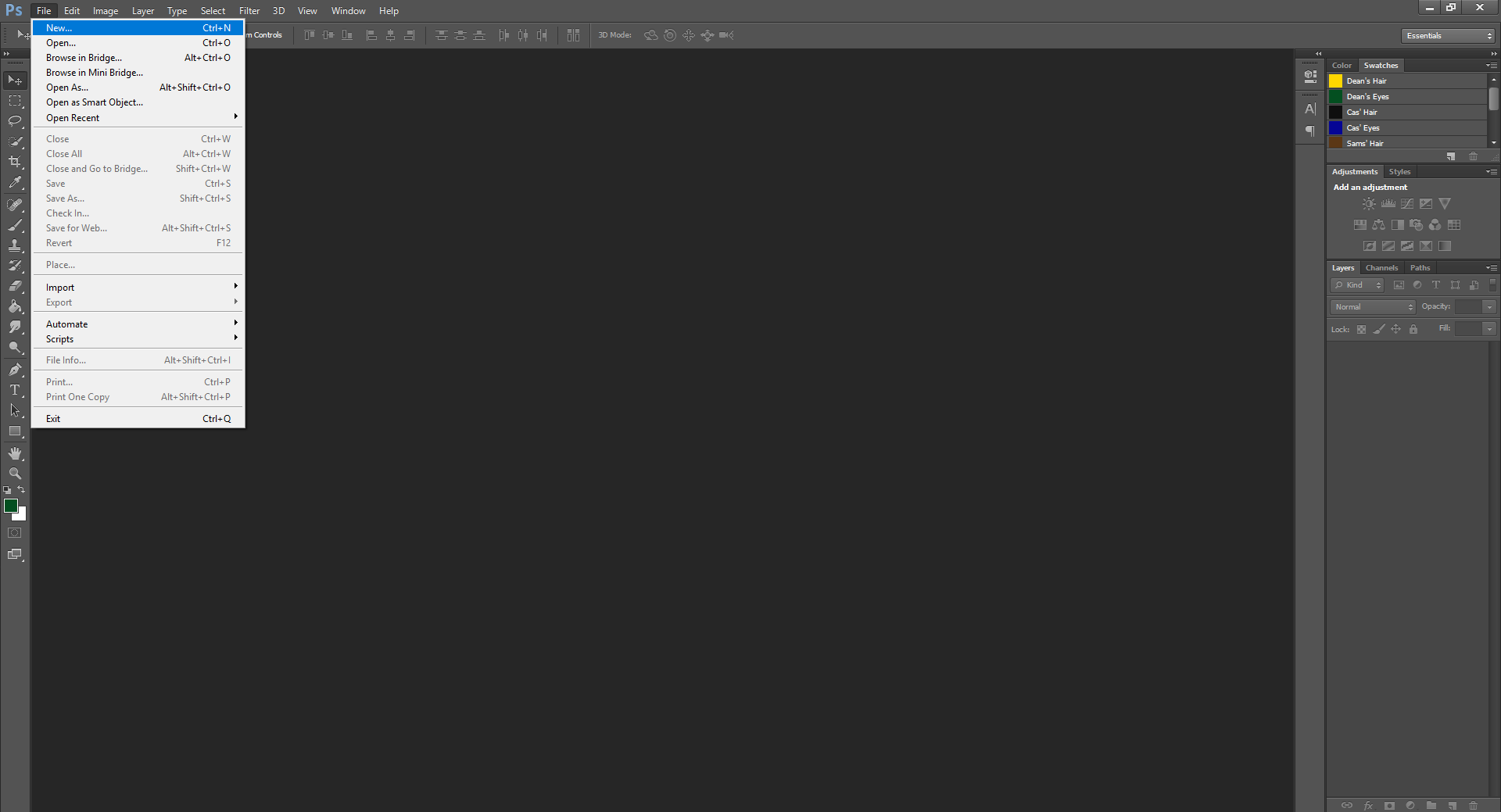
Step 4: In the box that popped up, give your file a name. I just chose to keep it simple.
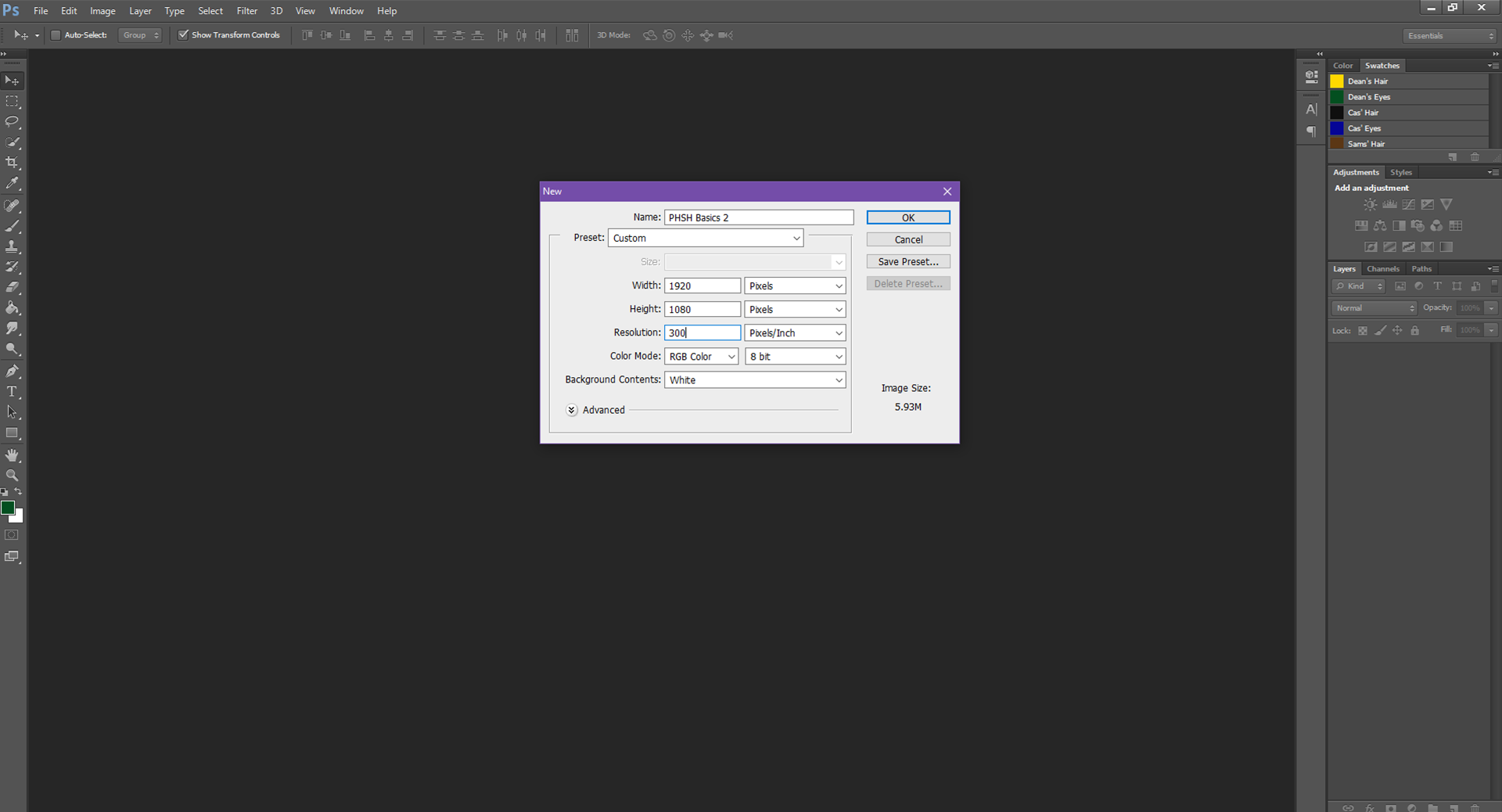
Tip: PHSH = short form for Photoshop. From here on out, I’ll be referring to the program by the short form, because it’s faster to type.
You’ll also want to set the dimensions. My dimensions are set to 1920×1080 (pixels) by default because I was taking screen-shots of myself opening PHSH for this tutorial. You can make the dimensions however big/small you want. You also don’t have to use ‘pixels’ as the unit of measure. I typically use inches. I would suggest you make your dimensions 10x10in for simplicity.
Also, if your Resolution is set to 72px by default, you’ll most likely want to change it to 300px – this will make the image clearer.
Once you do this, click the Okay button.
Step 5: Now that this is done, you should see a white page that’s to your specified dimensions. This is your document size.
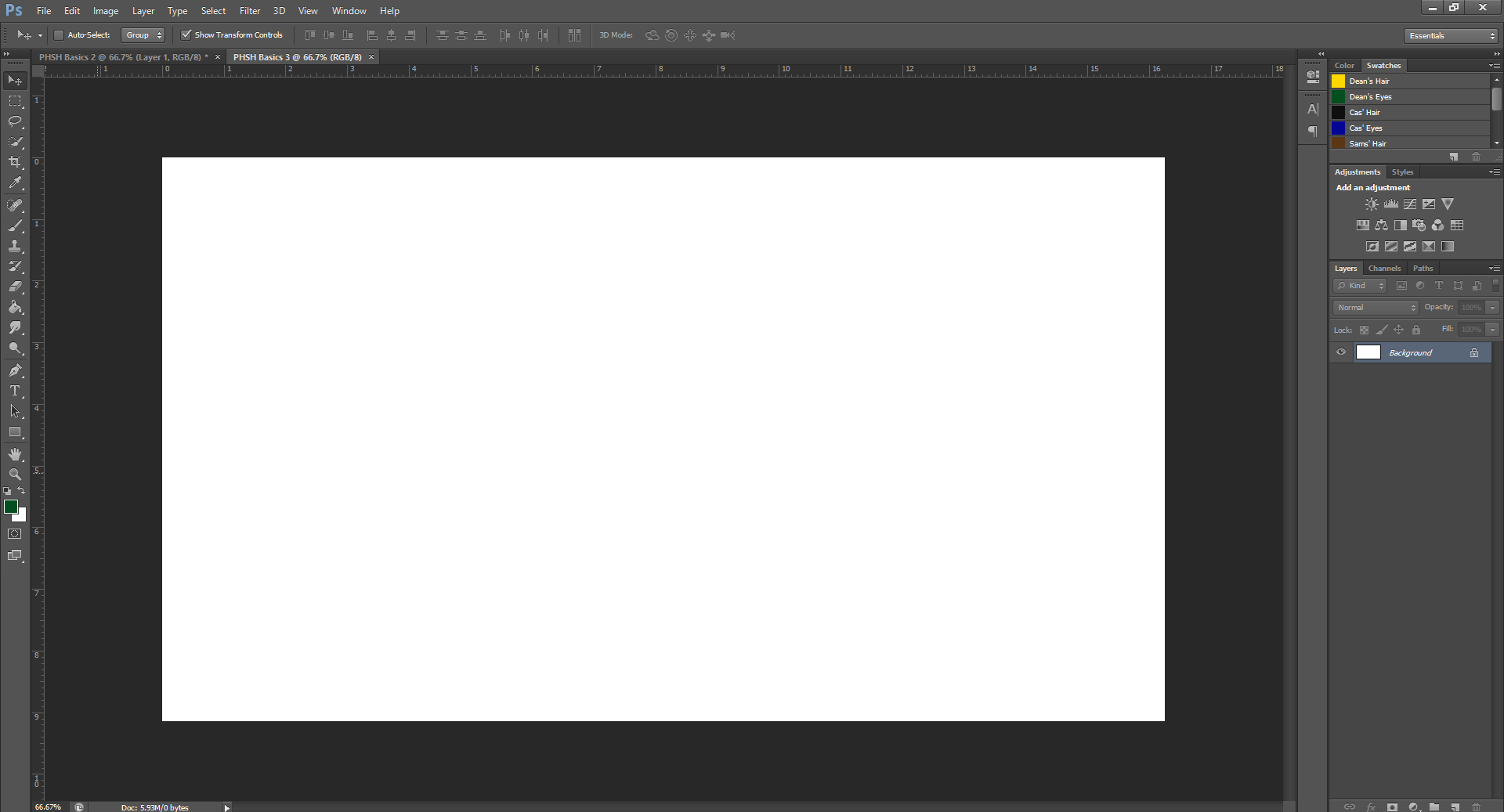
If you can’t see the edges of your document, you might be zoomed in. Hold down CTRL and press the minus button (beside the 0 on the keyboard) to Zoom Out. Zoom Out until you can see the edges of the document. This will make working easier.
Congratulations, you just made your first PHSH file! That wasn’t so hard, was it?
Alright, now I’ll be going through the Tools on the Toolbar that are listed down the left-side of the program.
![]()
This first one is the Pointer/Mouse function. It does exactly what you’d think – let’s you use your mouse as normal within the document. Allows you to click on different things, etc. You’ll be switching back to this a lot while you work, so it’s important you know what it does.

Next you have the Selection Tool. This allows you to make a selection around a certain part of an image, cut/crop/copy and/or protect a section of a picture from being Erased.
Actually, wait, I’m not gonna go through all the tools right now – I forgot a step. To show you what some of these tools do, you’re gonna need a picture!
Okay, so to Insert a Picture into a document:
Step 1: First, I want you to right click on the image below, and select Save Image As… from the menu. Give it a name, and save it to your Desktop, for simplicity.

Step 2: Now you have the image, go back up to File, and this time, instead of clicking ‘New’, click on Open.

This should bring you to your Desktop. Click on the image I just had you save, and then hit ‘Open’. This will open the image in a new PHSH document.
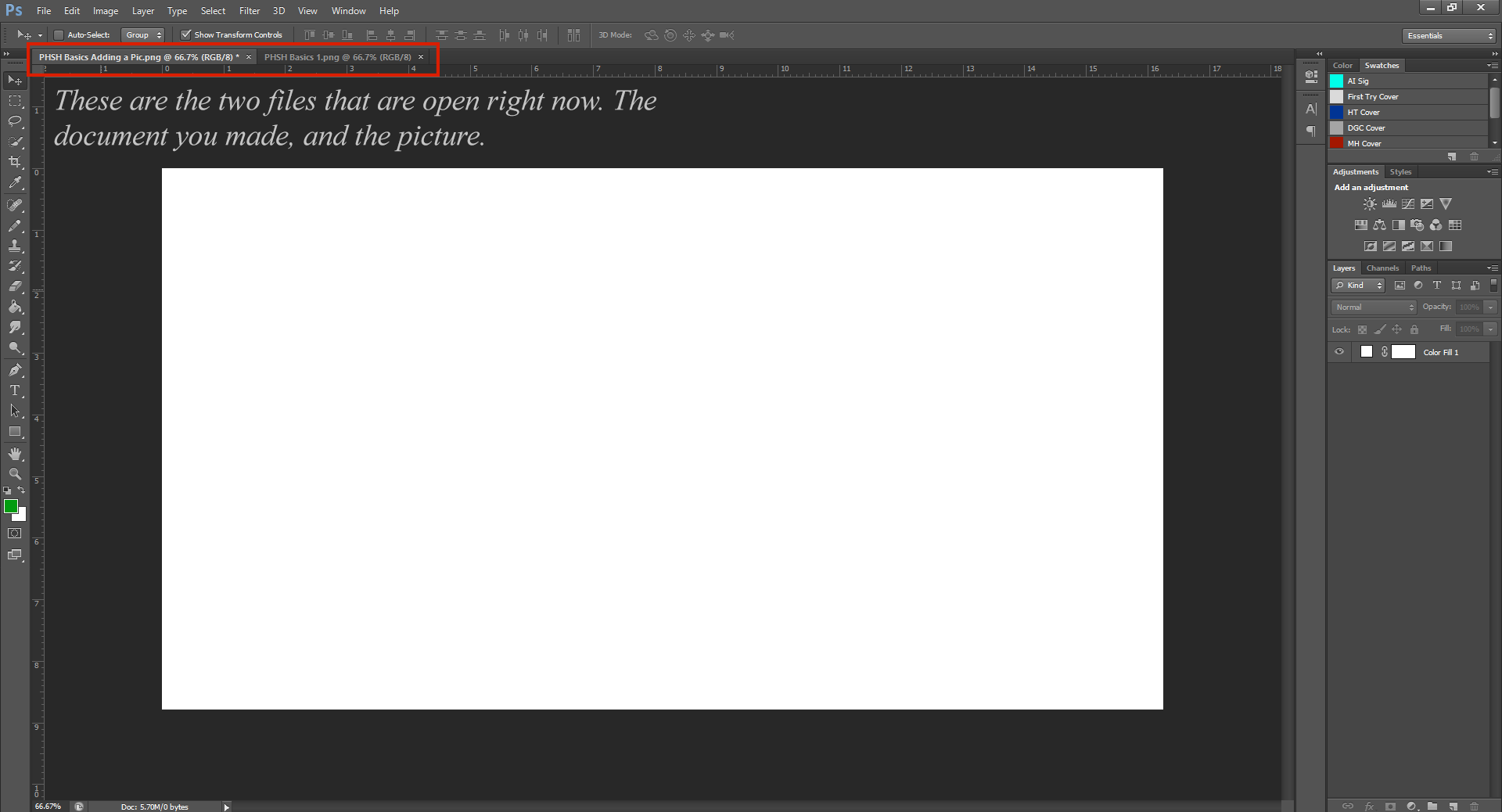
See those tabs? Anytime you have more then 1 PHSH file open, you’ll be able to switch between them by clicking on the tabs.
Step 3: Okay, now we have the image, and our blank document. You’re gonna want to move the picture to the new document.
To do this, you’ll want to click on the tab that’s the picture, and drag it off the line, a little to the left. Then let go – this makes the file open in a new PHSH window. (If you’ve ever accidentally opened a link in a new Window instead of Tab on your browser, it’s exactly the same as that, but in PHSH. If you haven’t done that, don’t worry.)

Now, click on the image itself, not the tab, and drag the image into the blank document. Let go once it’s there, and you should see a New Layer with the image was created in your blank document (which should now have the picture)


Now that we have the image in our document, you can Exit the image that’s still open in the window – we don’t need it anymore.
To center the image, click on Layer 1 (if it’s highlighted in Blue that layer is already selected) then, go back to your image, and drag it down into the document until it’s centered.

And that’s how you move a picture into your PHSH file!
Okay, now that we’ve covered that, I’ll be going back to some of the Tools.
I’ll go back to showing you the Select Tool.

Now that we have an image, I’m going to show you how to erase part of the image. (Especially because the PHSH pictures inside a PHSH picture is starting to confuse me, so we’re gonna fix that)
Okay, first: See the Rulers that are around the edges of the file? Click and drag down from the top Ruler – a turquoise/green line should now be on the document – this is called a Guideline. If you don’t have Rulers showing, go up to View and click on the Ruler option listed. (There should now be a check mark next to the option – this means it’s turned on)
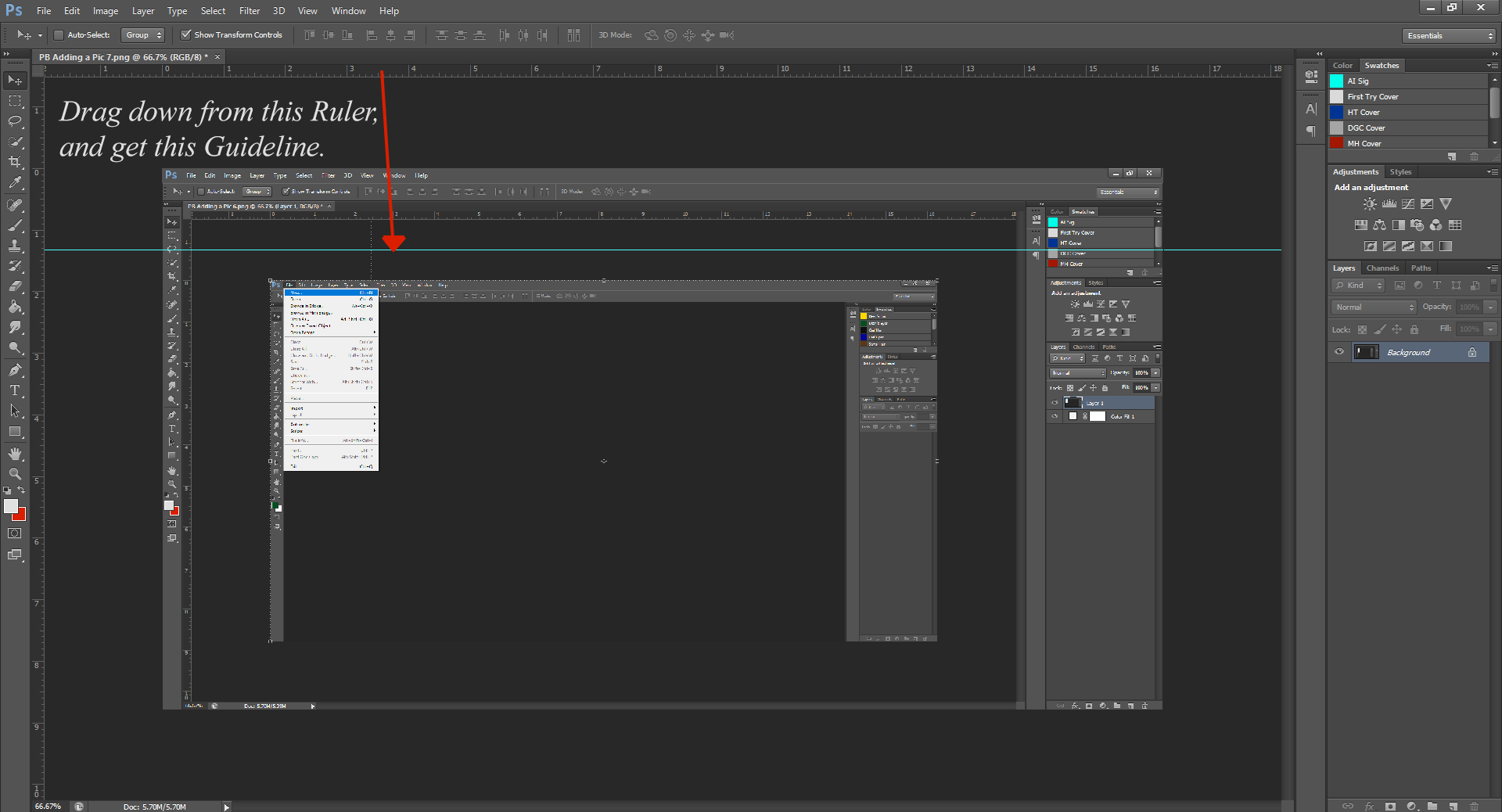
You’ll want to drag this Guideline to the edge of the image we centered. Then, go back up to the top, and drag another one to the bottom. Drag two more Guidelines out from the left-side Ruler, so now the image should be completely boxed in by the Guidelines.
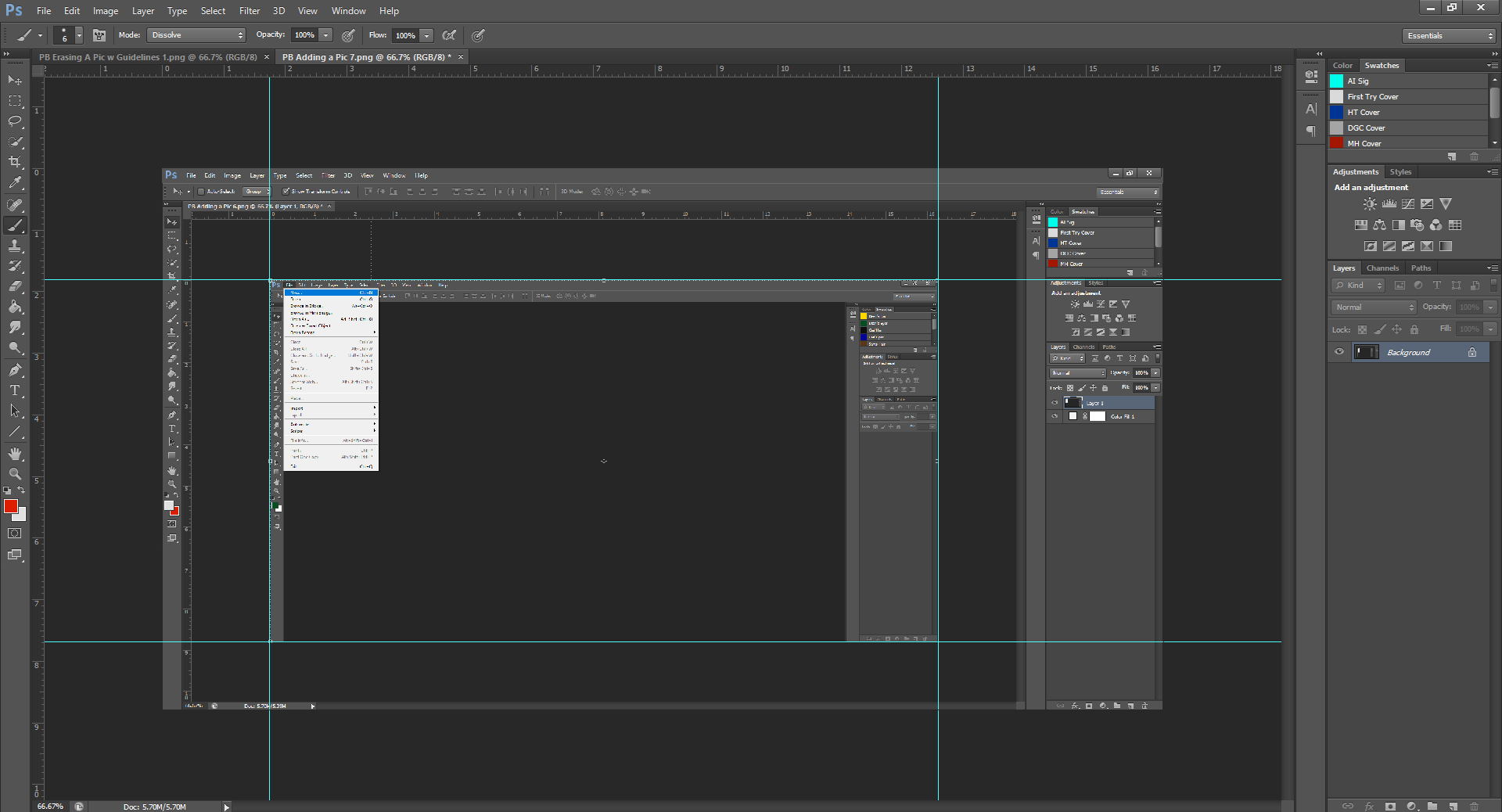
Now that you have your Guidelines in place, go over to the Toolbar, and click on the Select Tool.
Click and drag the outline box to the dimensions of the Guidelines. (It might ‘snap’ once you get close to the lines, that’s okay) Let go, and now you should see a dotted box along the Guidelines.

Right-click in the Selected box/Guideline area, and select the Select Inverse option. You should notice that now there’s a bigger perforated box outlining the whole picture.

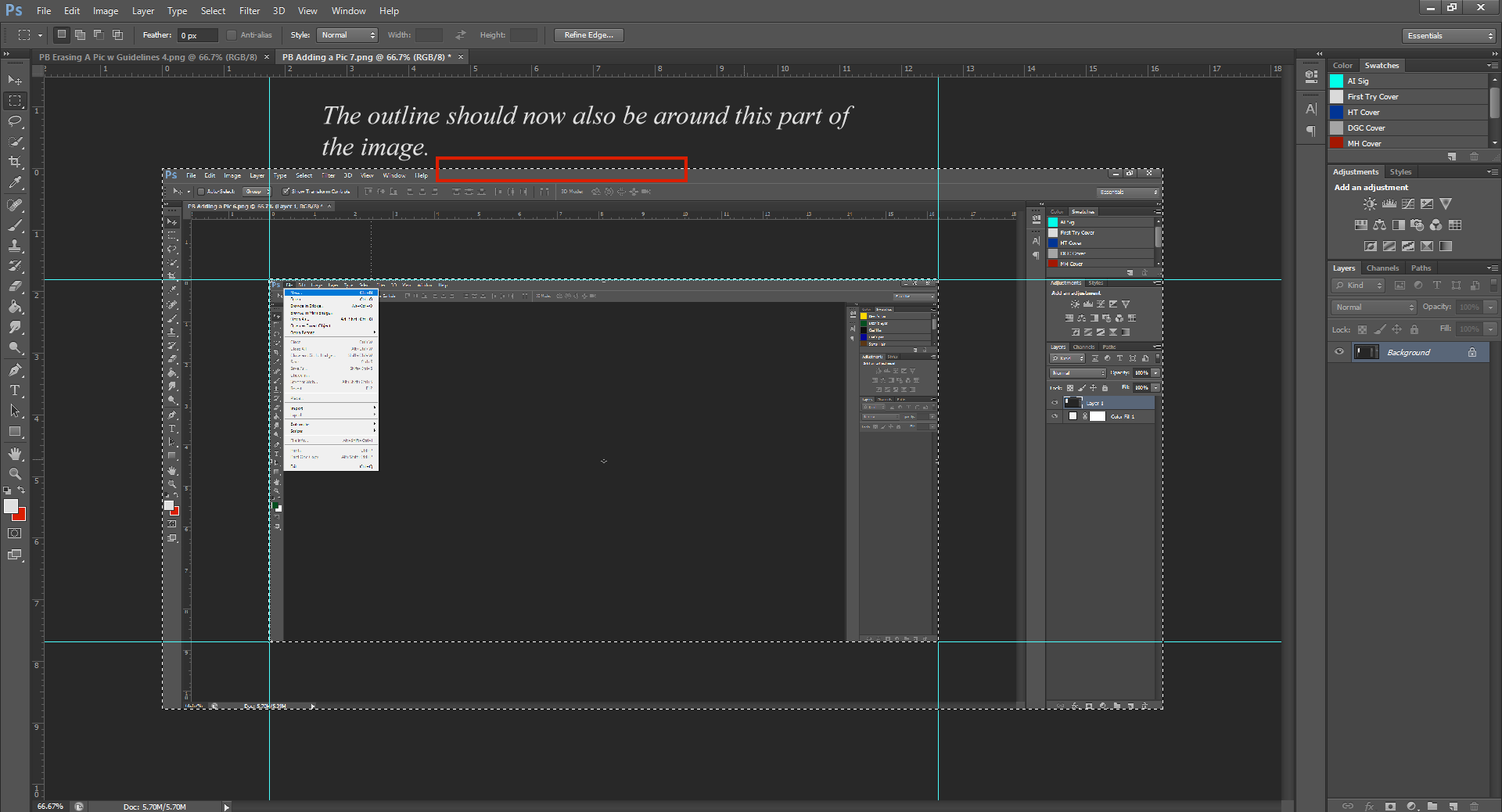
Now comes the less confusing part. Go back to your Toolbar, and select the Eraser tool.

Now that you’ve got the Eraser selected, click and drag your mouse (exactly how you used to do it in Paint) around the image, and you’ll begin erasing the outer-part, without touching the part we selected before. Because we inverted the selection, the part we want to keep is safe, and you’ll only erase the outside of the image, regardless of if your mouse touches the part we want to keep.

(Your background colour is hopefully white instead of red, don’t mind that. It’s typically white)
Continue erasing until just the middle part remains.

Now, go back up to the Select tool, right-click again on the image, and this time click on Deselect. Now the selected box is gone, you’re left with only the image. To get rid of the Guidelines, you can just drag them back up into the Rulers and they’ll disappear. (Make sure you switch from the Select tool back to the Mouse tool)


Now that we’ve erased the background, we need to change the dimensions of the document, to get rid of all the white space.
To do this, (the easiest way) is to drag the picture to the top left corner, and then place two Guidelines at the bottom and to the right of the image, taking note of the dimensions.
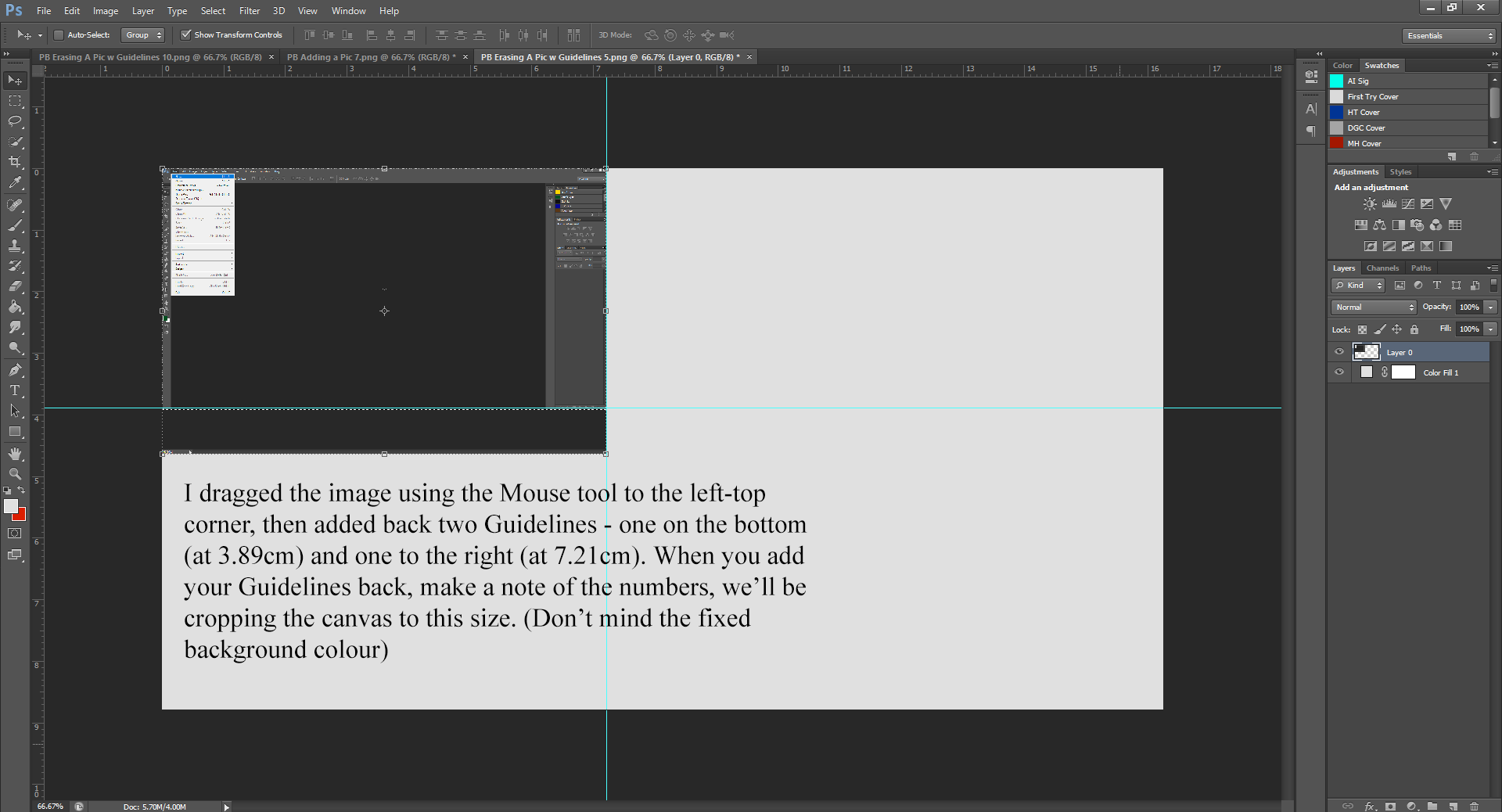
Once you’ve made a note of the Guideline dimensions, go to the menu at the top and click on Image, then go down to Canvas Size.
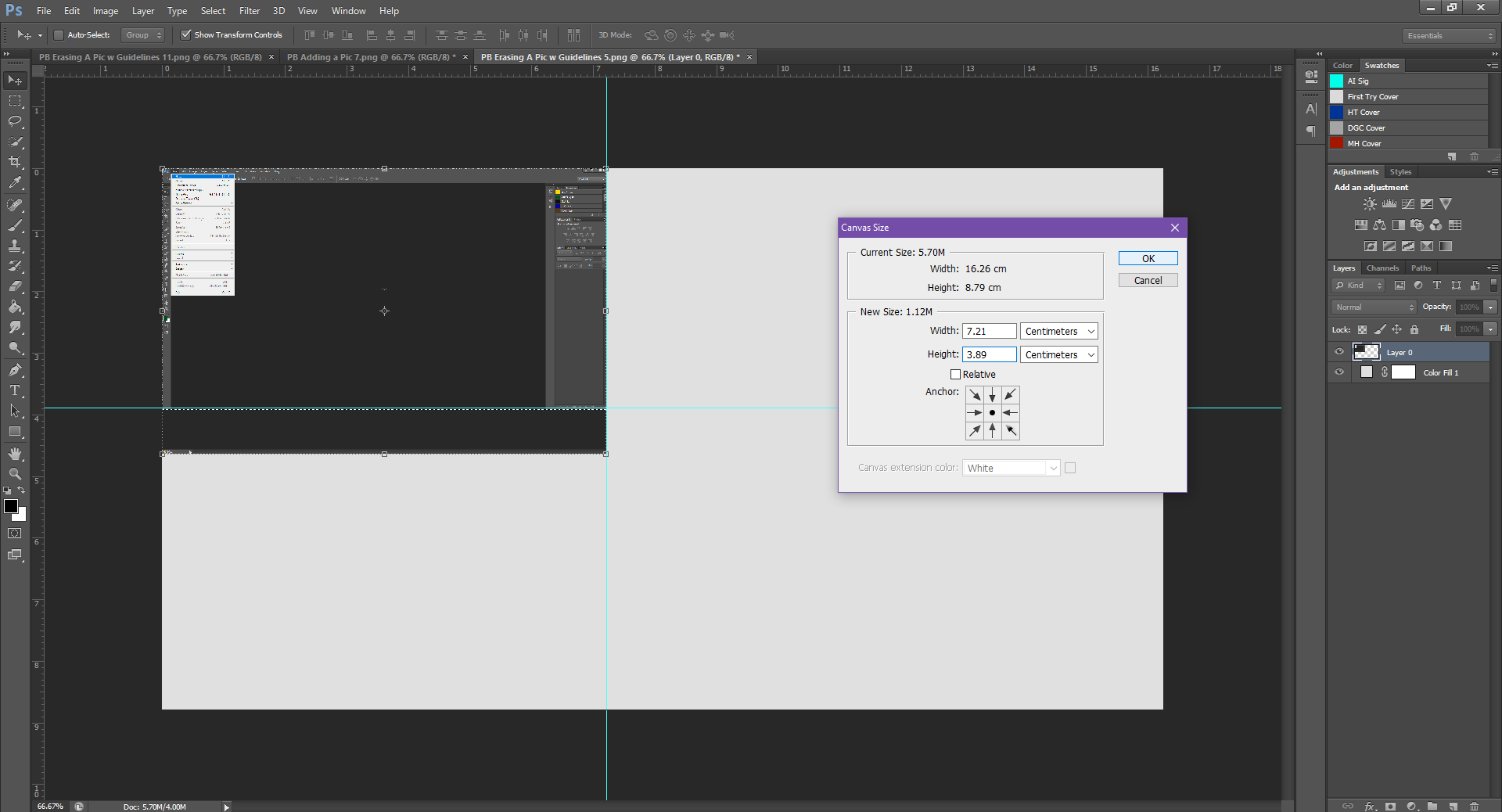

In the Canvas Size box, you’ll be able to change the dimensions of your canvas. Type in the dimensions you got from the Guidelines (mine were 3.89cm x 7.21cm) and click Okay.

Don’t freak out – your picture is still here! The canvas size shrunk, so now it’s outside of the canvas size. Using your Mouse tool, drag the image to be centered on the canvas again, and this time, it should be a perfect fit, with no white background showing.

The last step always: SAVE.

We’ll be saving two versions of the file. The first being a .psd or Photoshop file. Saving your work this way allows you to keep all the layers separate. This is especially handy should you need to return to the image later to edit it further. I usually label these saved files as ‘Whatever Project I’m Working On UNFlattened’ so at a glance, it’s faster to know which file is which.

The second version you’ll be saving as, is either a .png or a .jpeg. These are picture files that condense all the layers to be 1 image. These are usually the images that end up on websites, as profile pictures, and, most importantly, the ones allowed to be uploaded for your book cover. Amazon may also require a PDF version, you do it in exactly the same way, except instead of selecting PNG or JPEG from the list, you select PDF.



And there you have it! You now know how to make a new file, crop images, and save in a few different formats. That’s the most basic aspect of PHSH skills you’ll need.
Lastly, I’ll go through a few of the tools you’ll probably use the most.
I’ve already shown you the Mouse, Select and Eraser tool.

Because I don’t want this tutorial to go on too much longer, I’ll just go through the rest of Tools in point form.

Eye-Dropper – This allows you to ‘pick up’ a sample of colour from one part of the file, and use it elsewhere. You’ll notice when you use the Eye dropper, the colour you picked up is now in the Colour Swatches, allowing you to easily use the colour elsewhere in the document.






Paint-Bucket – Exactly what it used to do in Paint. It fills the entire area with whatever colour you select. (If you have it within a closed shape, it will only fill in the closed shape, not the whole canvas)
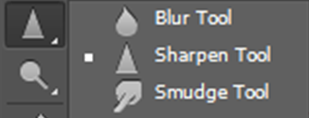
Blur/Sharpen/Smudge – Again, these do exactly as the name implies. They Blur, Sharpen and/or Smudge the picture. You can change the size of them similar to the Eraser tool. This is especially handy if say, you’re erasing a hair line, and need to not make the edges of hair so defined. (You would blur them slightly to make it look un-erased)
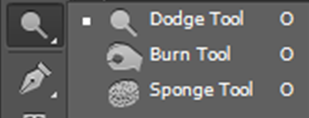
Dodge/Burn/Sponge – I’m not entirely sure what the Dodge or Sponge part of the this tool does (when I used the Dodge tool last, it made the picture turn a grey-er colour), but the Burn tool burns the picture like a lighter. Handy if you want to make the edges of an image appear burned, or if you want to blacken/darken the image as a whole.

Type – Allows you to add text to the picture. This is what I used to add the text on the images used in this tutorial.

Shape – Allows you to add different shapes to the canvas: Square, Rectangle, Line, etc.

Colour Squares – This is where it tells you what colours you’re currently using. The small arrow above the bigger boxes, will switch whatever colours you’re using currently to black and white.
Alight, I know that was a lot of info to take in, so take a breath – you made it all the way to end! Also, I’m sure that wasn’t nearly as daunting a task as you first thought it’d be. PHSH is funny like that, it’s such a big program, and there are a lot of different elements to it – at first glance it’s definitely intimidating. But it doesn’t need to be. All those different elements just mean you can make some kick-ass pictures with it!
I hope you enjoyed this intro to the world of PHSH, and feel free to practice and play around with the program a bit, that’s how I learned some of the stuff I know.
Next time, I’ll show you a very handy way to scale images without distorting them. You can look for that April 8th.
Like this article? Check out the rest of the tutorial series here!
Liking the site? Consider signing up for my Patreon, so I can continue bringing you the content you love!
